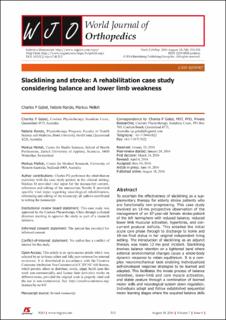Please use this identifier to cite or link to this item:
https://doi.org/10.21256/zhaw-1646| Publication type: | Article in scientific journal |
| Type of review: | Peer review (publication) |
| Title: | Slacklining and stroke : a rehabilitation case study considering balance and lower limb weakness |
| Authors: | Gabel, Charles Philip Rando, Natalie Melloh, Markus |
| DOI: | 10.21256/zhaw-1646 10.5312/wjo.v7.i8.513 |
| Published in: | World Journal of Orthopedics |
| Volume(Issue): | 7 |
| Issue: | 8 |
| Page(s): | 513 |
| Pages to: | 518 |
| Issue Date: | 18-Aug-2016 |
| Publisher / Ed. Institution: | Beijing Baishideng BioMed Scientific |
| Publisher / Ed. Institution: | Beijing |
| ISSN: | 2218-5836 |
| Language: | English |
| Subjects: | Stroke; Rehabilitation; Lower limbs; Balance; Slacklining |
| Subject (DDC): | 616: Internal medicine and diseases 700: The arts and entertainment |
| Abstract: | To ascertain the effectiveness of slacklining as a supplementary therapy for elderly stroke patients who are functionally non-progressing. This case study involved an 18-mo prospective observation of the management of an 87-year-old female stroke-patient of the left hemisphere with reduced balance, reduced lower limb muscular activation, hypertonia, and concurrent postural deficits. This entailed the initial acute care phase through to discharge to home and 18-mo final status in her original independent living setting. The introduction of slacklining as an adjunct therapy was made 12 mo post incident. Slacklining involves balance retention on a tightened band where external environmental changes cause a whole-body dynamic response to retain equilibrium. It is a complex neuromechanical task enabling individualized self-developed response strategies to be learned and adapted. This facilitates the innate process of balance retention, lower-limb and core muscle activation, and stable posture through a combination of learned motor skills and neurological system down regulation. Individuals adopt and follow established sequential motor learning stages where the acquired balance skills are achieved in a challenging composite-chain activity. Slacklining could be considered an adjunct therapy for lower limb stroke rehabilitation where function is compromised due to decreased muscle recruitment, decreased postural control and compromised balance. Initial inpatient rehabilitation involved one-month acute-care, one-month rehabilitation, and one-month transitional care prior to home discharge. A further six months of intensive outpatient rehabilitation was provided with five hourly sessions per week including:supervised and self-managed hydrotherapy, plus one individual and two group falls’ prevention sessions. These were supported by daily home exercises. At 12 mo post incident, recovery plateaued, then regressed following three falls. Rehabilitation was subsequently modified with the hydrotherapy retained and the group sessions replaced with an additional individual session supplemented with slacklining. The slacklining followed stages one and two of a standardized five-stage protocol. Self-reported functional progression resumed with improvement by 14 mo which further increased and was sustained 18 mo (Students’t test P < 0.05). Slacklining’s external stimulations activate global-body responses through innate balance, optimal postural and potentially down-regulated reflex control. Incorporated into stroke rehabilitation programs, slacklining can provide measurable functional gains. |
| URI: | https://digitalcollection.zhaw.ch/handle/11475/2671 |
| Fulltext version: | Published version |
| License (according to publishing contract): | CC BY-NC 4.0: Attribution - Non commercial 4.0 International |
| Departement: | School of Health Sciences |
| Organisational Unit: | Institute of Public Health (IPH) |
| Appears in collections: | Publikationen Gesundheit |
Files in This Item:
| File | Description | Size | Format | |
|---|---|---|---|---|
| 2016_Melloh_Slacklining and stroke_World Journal of Orthopedics.pdf | 1.21 MB | Adobe PDF |  View/Open |
Show full item record
Gabel, C. P., Rando, N., & Melloh, M. (2016). Slacklining and stroke : a rehabilitation case study considering balance and lower limb weakness. World Journal of Orthopedics, 7(8), 513–518. https://doi.org/10.21256/zhaw-1646
Gabel, C.P., Rando, N. and Melloh, M. (2016) ‘Slacklining and stroke : a rehabilitation case study considering balance and lower limb weakness’, World Journal of Orthopedics, 7(8), pp. 513–518. Available at: https://doi.org/10.21256/zhaw-1646.
C. P. Gabel, N. Rando, and M. Melloh, “Slacklining and stroke : a rehabilitation case study considering balance and lower limb weakness,” World Journal of Orthopedics, vol. 7, no. 8, pp. 513–518, Aug. 2016, doi: 10.21256/zhaw-1646.
GABEL, Charles Philip, Natalie RANDO und Markus MELLOH, 2016. Slacklining and stroke : a rehabilitation case study considering balance and lower limb weakness. World Journal of Orthopedics. 18 August 2016. Bd. 7, Nr. 8, S. 513–518. DOI 10.21256/zhaw-1646
Gabel, Charles Philip, Natalie Rando, and Markus Melloh. 2016. “Slacklining and Stroke : A Rehabilitation Case Study Considering Balance and Lower Limb Weakness.” World Journal of Orthopedics 7 (8): 513–18. https://doi.org/10.21256/zhaw-1646.
Gabel, Charles Philip, et al. “Slacklining and Stroke : A Rehabilitation Case Study Considering Balance and Lower Limb Weakness.” World Journal of Orthopedics, vol. 7, no. 8, Aug. 2016, pp. 513–18, https://doi.org/10.21256/zhaw-1646.
Items in DSpace are protected by copyright, with all rights reserved, unless otherwise indicated.